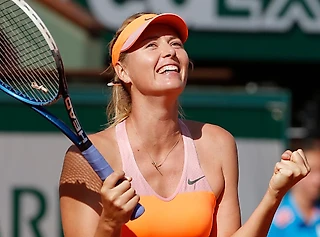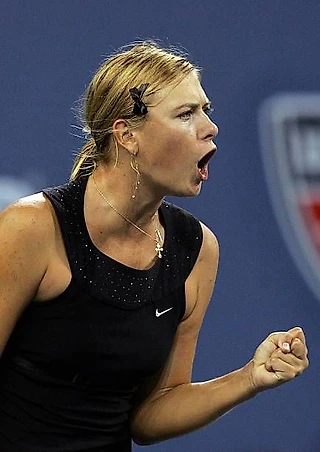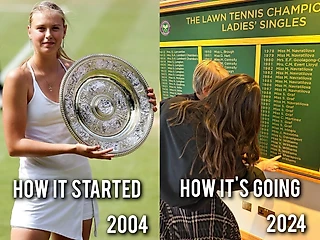No Frills, No Crowds, No Money: The Lonely Road to Tennis Glory
Ни излишеств, ни толп болельщиков, ни денег: сиротливая дорога к теннисной славе.
Эта статья рассказывает, как трудно вернуться в ТОП-100 и какова теннисная жизнь игроков, которые пытаются сделать это.
Вы, наверное, помните Александру Возняк, она была в ТОП-25. Прочитайте, через какие трудности ей сейчас приходится пройти, чтобы вернуться в большой теннис.
No Frills, No Crowds, No Money: The Lonely Road to Tennis Glory
For two players at distinct points in their careers, the path to the lucrative WTA Tour begins in small towns on the humbling Pro Circuit.
By DAVID WALDSTEINJUNE 26, 2017
Aleksandra Wozniak, left, shook hands with Claire Liu, who defeated Wozniak in the first round of an International Tennis Federation circuit tournament in Charlottesville, Va., in April. Credit Matt Eich for The New York Times
Less than a half-hour after a crushing defeat in front of two spectators, Aleksandra Wozniak paced the hallways of the municipal tennis center in Dothan, Ala., pleading on the phone with an airline representative.
Wozniak, a former top-25 player, had hoped to stay longer at the small tournament, but the loss forced her to immediately arrange a cheap 6 a.m. connection back home to Montreal. Once there, she would prepare anew for the next small tournament a week later in Charlottesville, Va., another lonely stop on a punishing minor league tennis tour.
In Dothan and Charlottesville, Wozniak, 29, competed alongside a special stratum of players struggling to claw their way out of tennis’s underappreciated lower rungs. Among those players is Fanny Stollar, a statuesque, 18-year-old Hungarian with hopes of joining the sport’s elite.
Stollar and Wozniak are at distinct stages in their careers. One is a rising prospect, the other a veteran making a comeback. But their goal — to play regularly on the WTA Tour — is the same, and for now they share a platform on the International Tennis Federation Pro Circuit, the junior varsity of professional tennis, where purses are too small to earn a living.
“This is not where I want to be,” Stollar said in late April in the small lounge area of the Boar’s Head Sports Club in Charlottesville. “But I have goals. This is where I have to be right now to reach them.”
Players on the Pro Circuit compete at remote stops like Dothan; Charlottesville; Andijan, Uzbekistan; and Yuxi, China. At any given time, 70 such tournaments may be taking place around the globe, with more than 2,000 players competing desperately for their hotel money, or less. Tennis distributes about $280 million in prize money each year, but 60 percent of that goes to the top 1 percent of the men on the ATP Tour and women on the WTA Tour, according to the International Tennis Federation.
On the Pro Circuit, there are usually only a few spectators standing courtside, or sitting on folding chairs. There may be a couple of line judges but no ball kids — the players pick up their own balls and towels, and no one will hold an umbrella over them.
On a sideline of a Pro Circuit match in Charlottesville. There may be 70 such tournaments taking place across the globe at any time, with more than 2,000 players competing for small cash prizes and a shot at joining the more lucrative ATP and WTA Tours. Credit Matt Eich for The New York Times
The travel costs for the players can be staggering and the logistical arrangements often self-made, adding layers of work and worry to an already demanding profession.
“I went to Australia in January and played three tournaments,” Wozniak said. “I spent 15 grand.”
Wozniak took in roughly $6,500 in prize money before taxes at those events, including a first-round loss in the Australian Open qualifying draw. (Serena Williams, the champion, won roughly $2.8 million.) Wozniak’s trip was a net loss. Same in Alabama, where she received $189 before taxes — minus the $40 entrance fee, of course.
This is a player who once beat Williams and was ranked No. 21 in the world in the summer of 2009. Today, after a series of injuries, Wozniak has tumbled to No. 317, but refuses to give up.
Pay to Play
In late April, Wozniak, Stollar and a few dozen other women gathered in Charlottesville for a $60,000 clay-court event — meaning the total prize money awarded to players is $60,000 (just a tick below the $36 million purse at the United States Open).
There are several levels of Pro Circuit tournaments, ranging from $15,000 to $100,000; all are sanctioned by the I.T.F. in conjunction with the local tennis federations. But they are separate from the more lucrative WTA Tour tournaments (or ATP Tour on the men’s side).
Everyone wants into the WTA events, but players must first attain a certain ranking, and to do that they turn to the Pro Circuit.
Stollar arrived in Charlottesville two nights before the tournament and bunked in a private home on the outskirts of the college town, along with her friend and fellow 18-year-old player, Usue Arconada. They also roomed together in Dothan.
The system of housing — club members often offer their homes to the players — is free. But the two women found themselves in a remote, cold house in the woods, so the next day Stollar booked them a hotel room, splitting the bill to reduce costs.
Fanny Stollar eating breakfast at the Homewood Suites by Hilton in Charlottesville, where she stayed during the tournament. Credit Matt Eich for The New York Times
Wozniak leaving the home of her host before a competition in Charlottesville. Players often stay in club members’ homes to save money on lodging during tournaments. Credit Matt Eich for The New York Times
That day Stollar took an Uber car to the club, where she met Federico Rodriguez, her coach at the time, for practice. Now ranked 204th, Stollar had zoomed up 86 places in the rankings to a career-high No. 201 after her family hired Rodriguez, a highly respected coach.
Stollar, the daughter of two Hungarian athletes who coached her and directed her career, grew up outside Budapest and showed early promise. She won the prestigious Eddie Herr 14-and-under championship in 2012 and was invited to train and attend school at the IMG Academy in Bradenton, Fla.
After three years there, she opted out of academy life and returned to Hungary for few months of restless soul-searching over the direction of her career. Stollar called last winter “a mess,” but the low point came in March, when she took a disastrous one-week trip to Australia — by herself. She played one match in a $25,000 event and left feeling frustrated and lost.
“I will never do that again,” she said of traveling alone. “It was so unprofessional. I did not feel like a professional tennis player. I felt like a tourist.”
Soon after, she returned to Florida to begin working with Rodriguez. In April, Stollar notched her most significant victory yet, beating Elena Vesnina, ranked 14th at the time, at a WTA event in Charleston, S.C. But the partnership with Rodriguez ended in June, when Stollar, after some back and forth and intervention from her mother, hired Adam Altschuler to help her prepare for Wimbledon’s qualifying event.
Because of her promise and age, Stollar has all the things Wozniak does not, including a traveling coach, a full-time agent in Matthew Fawcett of Creative Artists Agency, endorsements from Nike and Babolat, and a token financial contribution from the Hungarian tennis federation.
Stollar’s mother, Yvette Varga, and her father (and first coach), Tibor Stollar, once handled all of her logistical arrangements. They chose the tournaments she played in, organized her schedule and arranged flights, trains, hotels and food. Now, Varga simply handles the flights while Fawcett books the lodging — unless, of course, his client overrules him and checks into a hotel.
“It was too cold,” Fanny Stollar said of the housing in Charlottesville. “We were shivering.”
On the Pro Circuit, every dollar is counted, every taxi fare carefully considered and every meal tempered by the expense. Varga estimated that it costs $100,000 per year to get her daughter from tournament to tournament, and double that if you have to pay for a traveling coach.
Stollar has earned $24,844 in prize money this year. Varga said the additional money from endorsements and the Hungarian tennis federation did not nearly cover her daughter’s expenses.
Stollar’s parents said they would contribute what they could until she could turn a profit — or at least break even — on the WTA Tour. That usually means getting inside the top 100, and the financial burdens add even more pressure to an aspiring young pro.
“I have no idea how long we can do this,” Varga said in Paris last month during the French Open, where Stollar lost in the first round of the qualifying draw. “We have to survive this period and hope it is short.”
Stollar, 18, left, and Wozniak, 29, before matches in Virginia. One is a rising prospect, the other a veteran making a comeback, but both hope to play regularly on the WTA Tour.
Credit Matt Eich for The New York Times
Starting From Zero
A first-round loser in leafy Charlottesville takes home only $533, barely enough to cover a plane ticket — that is, if the player is flush enough to fly. Elena Bovina, a Russian formerly ranked 14th, is attempting a comeback and drove her minivan 13½ hours from Dothan to Charlottesville. Not surprisingly after her grueling journey, she lost in the first round of qualifying, and earned nothing.
Like Stollar, Wozniak travels by plane, but she does it all alone. There is no traveling coach, agent or trainer to share the burden with her, to support her on lonely nights in tiny towns, to celebrate a big victory or just help her carry her luggage.
Until May, when the Iris the Visual Group, in Montreal, renewed a modest sponsorship deal to pay for flights and hotels, Wozniak had no significant endorsements, and she no longer receives money from Tennis Canada.
She once had it all, but when her rankings caved, monetary support mostly evaporated. Now she spends as much time arranging her travel and finances as working on her volley.
Before her first-round match in Charlottesville, Wozniak sat by the front desk of the club and prepared for the competition not by stretching or meditating, but by decorating her racket face in accordance with her recent contract with Yonex, the manufacturer that provides her with rackets, string and a red bag to carry it all.
Wozniak rummaged around and found a plastic stencil, placed it over the strings of her racket, then took a fat black marker and colored in the Yonex logo as she chatted amiably.
“You can’t forget to do it or you could lose your sponsorship deal,” she said.
Stollar eating breakfast while her coach painted a sponsor’s logo on her racket. Forgetting to display the logo could cost a player the sponsorship. Credit Matt Eich for The New York Times
Racket strings can be another hidden cost. Each tournament provides a stringer, but stringing costs $20 per racket. Wozniak said she took six rackets and 30 reels of polyester string, also provided free by Yonex, to each tournament. Until this year with Yonex, she was spending $90 per package for gut strings and stringing three to six rackets per match.
Wozniak can detail every aspect of her routine and recall every expense.
She began playing tennis at 3 in Blainville, Quebec, outside Montreal, so none of this labor is new. In many ways, her current life mirrors her old one as a junior, except that now she is alone.
As a promising youngster, Wozniak was coached by her father, Antoni, a mechanic, who kept their Nissan Micra running years past its normal life expectancy. He drove it across North America and back, seemingly dozens of times, to ferry his daughter to junior amateur tournaments.
Wozniak nicknamed it Mr. Bean’s Car, from the British television show, and said it had 400,000 kilometers (about 249,000 miles) on it.
When her father could not travel, Wozniak’s mother took her on Greyhound buses, zigzagging across the southern United States.
“Some of those bus stops were in scary places,” she recalled. “My rackets would be in the bottom of the bus, and I would sit by the window so I could look outside in case anyone took them.”
Eventually, Wozniak made good money on the WTA Tour and in Grand Slam events, where even a first-round exit can be worth $30,000. With more than $2 million in career prize money, she built up some equity. But her current quest to return to the elite level of tennis is siphoning off her accounts in a steady drip.
“This is the third time in my career I’ve had to start from zero,” she said.
Injuries are a constant threat for athletes, and Wozniak has endured her share of physical ailments. But seven years ago, she also faced a serious emotional malady that cost her time and money.
“April 2010 was the toughest moment of my life,” Wozniak said. “I had been through burnout and depression. I have never talked about it. There was so much pressure that I had built up after reaching 21 in the world.”
Wozniak during a match at Wimbledon in 2010. That year she hit an emotional low point that affected her career. Credit Julian Finney/Getty Images
Her parents and older sister helped her through that dark period of inactivity, but if tennis players don’t play because of illness or injury, they don’t get paid.
Wozniak’s ranking plummeted to No. 200, but she fought back and reached No. 41 in 2012. Then a complicated shoulder surgery at age 27 cost her an entire year. Her ranking ballooned to No. 946 in 2015, but by last year she had whittled it down to 287th by playing tiny tournaments in Stillwater, Okla.; Albuquerque; and Gatineau, Quebec.
Occasionally at those outposts, the daily routine can be demeaning for proud athletes. Most tournaments require a $40 entrance fee, which is deducted from the player’s earnings. But since there is no prize money for a loss in the first round of qualifying, some tournaments ask for the entrance fee upfront — in cash.
In Surprise, Ariz., last year, Wozniak said, she had only a $20 bill on her, so she borrowed the other $20 from the American player Ashley Weinhold. Wozniak did well in Surprise, winning five matches. But even that brought up the inherent financial paradox of the smaller tournaments: She had to stay longer in her hotel — 10 days for a total of $2,500 just for lodging — and she earned only $654 for reaching the quarterfinals.
At least she was able to pay back Weinhold.
Moving On
Stollar won her first-round match in Charlottesville against Carol Zhao in straight sets. She stayed at the club through the afternoon, mingling with the other players, most of whom she knew, and worked out again with Rodriguez. The next day was Rodriguez’s birthday, and Stollar, with the help of the hotel’s reception desk, ordered a special gluten-free cake for her coach.
Then she took an Uber car back to her room at the Homewood Suites, where she had a typical night on the road talking to her mother and friends on FaceTime. Rodriguez went out and brought back sushi, Stollar’s favorite, and had it sent to her room.
But the next day, Stollar lost to Claire Liu in straight sets. Her mother, ever intent on her daughter’s progress, watched nervously on a live-stream feed from their home outside Budapest, and then immediately called a travel agent to arrange Stollar’s next flight. Within an hour, Stollar and Rodriguez had received email confirmations from a Hungarian travel agent for their flights back to Boca Raton, Fla., where Stollar was training and staying with Rodriguez’s family.
Their flight left before Rodriguez’s birthday cake was ready.
“It’s too bad,” Stollar said. “But you know, we can’t change all our plans for a cake.”
By then, Wozniak was already on her way back to Montreal. She lost in the first round at Charlottesville — also to Liu — with a half-dozen people watching, including her host, Stephanie Scheel. For Wozniak, staying in the free housing was the only sensible choice.
“She was such a nice guest,” Scheel said. “She even did her own dishes.”
Wozniak stretching before competing in Virginia. After having reached No. 21, then plummeting to as low as No. 946, she is slowly working her way back up the rankings. “This is the third time in my career I’ve had to start from zero,” she said.
Credit Matt Eich for The New York Times
After the loss, Wozniak marched off court with a scowl and went directly to the exercise room to work out for an hour before heading into the club’s business office. There, she collected her prize money: $228.
She estimated she had spent $2,500 on the trip.
With a ride from an acquaintance back to her host’s house in the late afternoon, she at least saved a few bucks on a taxi.
“It’s a grind, for sure,” Wozniak said. “People don’t understand what we go through. It’s lonely out here. But this is my passion. I’m doing what I have to do to play tennis.”
>








Александре и всем остальным игрокам, переживающим подобные трудности, сил и терпения. Хотя, мне кажется, нынешним 20-летним во всех сферах непросто. А в теннисе в случае успеха можно сорвать неплохой куш, что есть далеко не во всех сферах.
Так нарубили бы дров! Ох уж эти теннисисты!
:)))))))
Так яснее!
Но я настолько плохой в области одежды, что трудно понимаю что это такое на любом языке!
Даже если девушка покажет мне такое платье, я быстро забуду это платье, запомню только тело девушки!
:):):)
Но здесь имеется в виду теннис. И ставится важный вопрос, о котором уже говорил внизу "Василий 2016".
Постоянно, каждый год увеличиваются деньги для самых сильных игроков. А никто не думает о тех, кто в начале теннисной карьеры или о тех, как Возняк, кто из-за травмы или из-за других причин уже не среди лучших и пытаются вернутся туда где были.
Деньги очень много в теннисе. Но они очень неправильно распределены. Можно создать более хорошие условия для всех, а не только за ТОП-50 или ТОП-100.